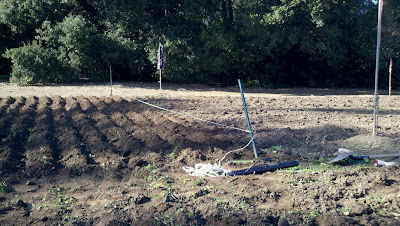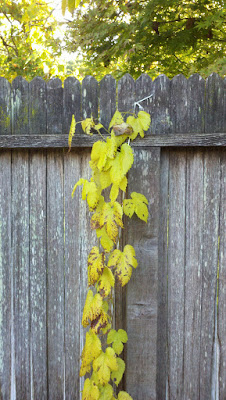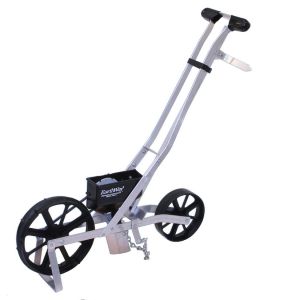Last week the entire field was disced by a local ranch. The discer is a big device dragged by a tractor -- it's two big rows of steel discs that cut into the soil, and each disc has a metal bracket extending to the side. They simultaneously chop up whatever was standing in the field and churn up about 8" of soil. This has a different effect on the soil than plowing, but I'm not sure how -- perhaps someone else knows?
I followed with a shovel to dig out the corners of the field that the discer missed. Then I began making 14" East-West rows to hold barley seed. The soil is loose in most parts of the field, and this job is easier than it sounds. Still exhausting, though, about as intense as jogging, and I can go for an hour and a half at a time before my arms turn to jelly, getting 800 square feet done in one go. Should be finished tomorrow! I use posts and nylon rope to keep the rows straight, measuring tape to keep them even.

I ordered 2-row Conlon seed from http://www.johnnyseeds.com and a mix of harvested malting barley seed adapted to Colorado from http://coloradomaltingcompany.com I expect disease will be big problem, based on the advice I received from a plant breeder at UC Davis who is attempting to create a California-adapted malting barley cultivar. So, I want as much diversity in my seeds as possible, in case some are better suited to the area than others. I'll seed part of my field with the single cultivar and part with the mix.
I'm planting all spring 2-row, now in November, as soon as the field is ready. Fall-sown Spring barley is how we do it in California. Apparently, winter barleys achieve their frost-resistance, in part, through delaying flowering until after a long period of cold temperatures. If you don't expect any freezing during the winter, then choosing a winter barley will only delay harvest time. It does freeze here in Palo Alto, but it's only a few nights a year, and only a degree or two below 0 C. Things get colder in Davis, where all the local barley knowledge comes from, so I'm confident about sowing spring barley in the fall.
In planning: a technique for seeding. Any advice here is much appreciated! I don't have a seeder, so I'll have to do it by hand. Any ideas to avoid the pain of planting 45,000 seeds? I'm thinking of dragging a metal rod across each row to dig a 1-2" trench, then following with a PVC tube with funnel attached to top, pouring seeds into funnel. Then cover seeds by dragging a metal chain along rows, followed with packing by foot.
Another option would be to build a makeshift seeder. The least desirable option is to spend $90 on a real one. Any advice here?
Last year's work: Planted 11 hop rhizomes in my backyard. Ordered from freshops and picked up locally at MoreBeer. The quality was very poor, and only five survived! This spring, I expect cones from one plant each of Cluster, Chinook, Columbus, and Glacier. A Goldings plant grew anemically last year, so I'm not sure if I'll get cones from it. I left the bines up so they could feed the roots as much as possible, but they're dying now. This is the Cluster:

Depending on the yield of the barley, I'll get enough for anywhere from 0 - 20 batches of beer. I'm setting my expectations low, because from what people tell me, this is hard. If I can get enough barley to survive aphids, scald, stripe rust, and yellow dwarf virus, get it all threshed, malt it without any fungal growth, kiln it without destroying enzymes, then get enough hops to balance 5 gallons of beer, I will be more than happy.
There's a brewer, Mark VanGlad, who did everything except the malting at a commercial scale.
Why do this? Same reasons we brew, brothers and sisters. Because we can!







